#Sarah Winnemucca
Explore tagged Tumblr posts
Text
Sarah Winnemucca: 19th Century Advocate for Native Americans
Last month I wrote about Winema Riddle, a Native American woman who pursued justice for her people in 19th century Oregon. Sarah Winnemucca was another prominent Native American woman in Oregon at the time who also advocated for her people. Sarah Winnemucca was born into an influential Northern Paiute family in what is now Nevada. Her Paiute name as a child was Thocmetony, meaning Shell Flower,…

View On WordPress
3 notes
·
View notes
Text
Sarah Winnemucca
March is Women's History Month. How much do you know about influential Native American women? Sarah Winnemucca was an author and orator who worked to bring awareness of the treatment of her people during the Gold Rush years.
Image courtesy of the Nevada Historical Society As I sit here on land which was traditionally the homeland of the Southern Paiute or Nuwuvi people, I want to offer my gratitude for the land itself and honor those who for whom these lands offer their gratitude. In mainstream culture, it is March. March is Women’s History Month. Those who reside in Northern Nevada (traditionally the homeland of…

View On WordPress
2 notes
·
View notes
Text
i try to be good abt writing notes for readings but i got interrupted bc i remembered i had to do smth. n i really came back to my notes to see the singular bullet point "winnemuca..."
#alli says shit#my professor last semester kept talking abt winnemucca nevada n having to drive thru it#n now every time i see winnemucca my brain just goes. winnemucca...#anyways sarah winnemucca hopkins i'm sorry
3 notes
·
View notes
Photo

Twelve Famous Native American Women
Native American women are traditionally held in high regard among the diverse nations, whether a given people are matrilineal or patrilineal. Traditionally, women were not only responsible for raising children and caring for the home but also planted and harvested the crops, built the homes, and engaged in trade, as well as having a voice in government.
The history of the women of the Native peoples of North America attests to their full participation in the community whether as elders and "medicine women" or as skilled agriculturalists and merchants and, in some cases, even warriors. Although hunting and warfare were traditionally the provenance of males, some women became famous for their courage and skill in battle. These women, as well as others in the arts and sciences, are often overlooked because they do not fit the paradigm of what has been accepted as American history.
Pocahontas and Sacagawea are usually the only North American Native women that non-Natives have heard of, but even their narratives have been obscured by legend and half-truths. Many other Native American women have simply been ignored, and among them are most of those listed below. These women, and the nations they were citizens of, include:
Jigonhsasee – Iroquois
Pocahontas – Powhattan
Weetamoo – Wampanoag
Glory-of-the-Morning – Ho-Chunk/Winnebago
Sacagawea – Shoshone
Old-Lady-Grieves-the-Enemy – Pawnee
Pine Leaf/Woman Chief – Crow
Lozen – Apache
Buffalo Calf Road Woman – Cheyenne
Thocmentony/Sarah Winnemucca – Paiute
Susan La Flesche Picotte – Omaha
Molly Spotted Elk/Mary Alice Nelson – Penobscot
There are many others who do not appear here because they are more widely known, such as the Yankton Dakota activist, musician, and writer, Zitkala-Sa (l. 1876-1938) or the Cheyenne warrior Mochi ("Buffalo Calf", l. c. 1841-1881). Modern-day figures are also omitted but deserve mention, such as the activist Isabella Aiukli Cornell of the Choctaw nation, who drew national attention in 2018 with her red prom dress designed to call attention to the many missing and murdered indigenous women across North America, and poet/activist Suzan Shown Harjo of the Muscogee/Southern Cheyenne nation. There are many more, like these two, who have devoted themselves to raising awareness of the challenges facing Native Americans and continue the same struggle, in various ways, as the women of the past.
Jigonhsasee (l. c. 1142 or 15th century)
According to Iroquois lore, Jigonhsasee (Jikonhsaseh, Jikonsase) was integral to the origins of the Haudenosaunee (Iroquois) Confederacy dated to either the 12th or 15th century. She was an Iroquoian whose home was along the central path used by warriors going to and from battle and became well-known for the hospitality and wise counsel she offered them. The Great Peacemaker (Deganawida) chose her to help him form the Iroquois Confederacy, based on the model of a family living together in one longhouse, and, along with Hiawatha, this vision became a reality. Jigonhsasee became known as the 'Mother of Nations' and established the policy of women choosing the chiefs of the council in the interests of peace, instead of war. The American women's suffrage movement of the 19th century called attention to the freedom and rights of Native American women, notably those of the Iroquois Confederacy, in arguing for those same rights for themselves.
Continue reading...
92 notes
·
View notes
Text
WOLFER --- The real California history behind the Tomione Fic
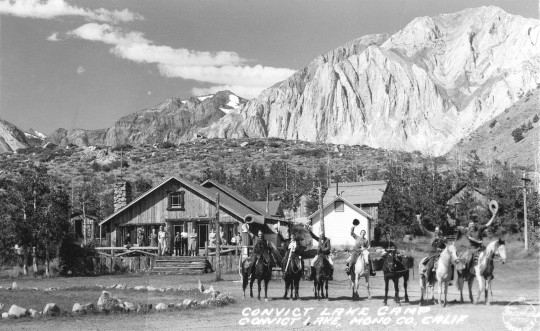
Convict Lake Camp (OwensValleyHistory.com)
When I was a kid, my family frequently visited Bishop, California. I can still feel the light-headed enchantment of hopping out of the van at a relative's green, creek-watered ranch shadowed by towering granite faces of the High Sierras. The dusty road and sage-sharp aroma propelled my imagination two hundred years into the past.
Wolfer is set in 1890 Bishop Creek, and while some of the location names are changed to fit the story, the town really had ranching barons like the Sacred 28 families, churches which exerted certain levels of social power with the well-to-do folk, boarding houses for mill workers and on-farm worker housing for fruit pickers and cowboys--or perhaps the odd wolfer.
It's amazing what you can dig up when you're procrastinating working on your WIP, lol. I did a lot of initial research while writing a Gingerrose fic set in post Civil War Bishop Creek.
Here are some things I found.

Main Street, Bishop Creek 1880 (OwensValleyHistory.com)
In Chapter 1, Tom rides down Main Street to the marshal's office (played by a grudging Severus Snape) and runs into Hermione.
Way off into the upper right you can see the steeple of the First Baptist Church on Main Street.

East Line Street, Bishop Creek (OwensValleyHistory.com)
Tom chases Hermione to Line Street, where he pushes her up against the Brown's Machine Shed, which is of course re-named to fit Lavender Brown's family.
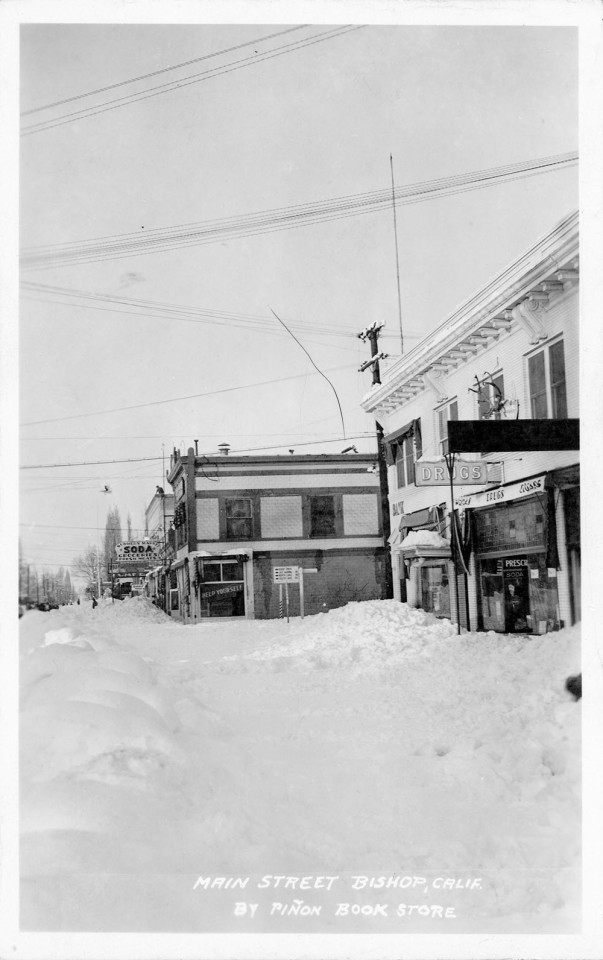
(OwensValleyHistory.com)
Check out that snow! Sitting at 4,000 feet of elevation in the foothills of the East Sierras, the snow can get quite voluminous.
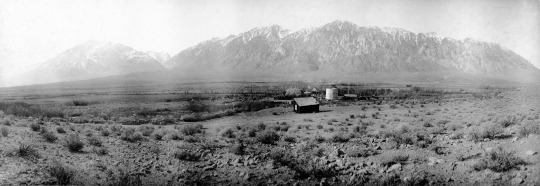
W.D. Roberts Ranch, Round Valley (OwensValleyHistory.com)
The ranch near the dry saltbeds of Owens Lake where Draco visits Harry, (by way of Mad Eye Moody) might have looked like this.

Cerro Gordo photo taken some time between 1871 - 1879 (OwensValleyHistory.com
We get a brief glimpse of the Cerro Gordo silver mine when Draco and Harry ride off into the sunset together for a night of wild debauchery. The brothels and bawdy houses within these sprawling mining towns would have perhaps been some of the only public places for late 19th-century gays to be themselves. Miss Lola's was among the more famous, and I'm struggling to find the website where I originally learned this this but I believe she hosted queer sex workers and provided space for an early LGBTQ+ scene.
The silver mine itself brought together a richly diverse group of fortune seekers. I accessed California census documents and found that while Bishop Creek was mostly white, Cerro Gordo had a much more diverse population (interestingly all marked with 'I', even Latinx names).
I did a phone interview with the Inyo Historical Society and chatted for an hour with a local historian, telling him I was getting context for a novel. (He didn't need to know that my novel was also a fanfic, hahaha.) The historian told me the mine had Mexican, Black, Chinese, and Indigenous populations working as miners, teamsters (people who drive wagons), cooks, brick masons, farm laborers and all kinds of interesting jobs related to running the mine.
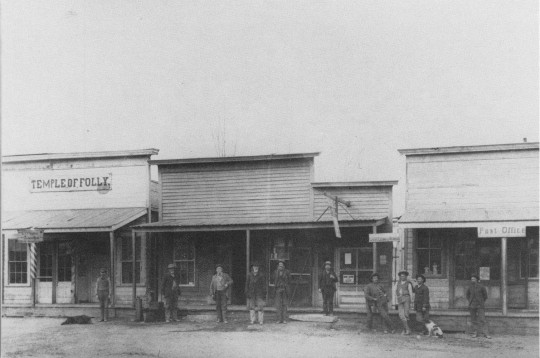
Main Street in Bishop Creek, 1878 (OwensValleyHistory.com
One thing that sticks out in my mind from the conversation with the historian is how the white and Mexican ranchers demolished the irrigation canals the Numuu Indigenous tribes had dug to create a green landscape in Owens Valley. Native Americans have been 'farming' America's landscape for thousands of years in a low-impact way. In Chapter 4, Tom muses on this detail as he's setting a wolf trap on Rosier's ranch.
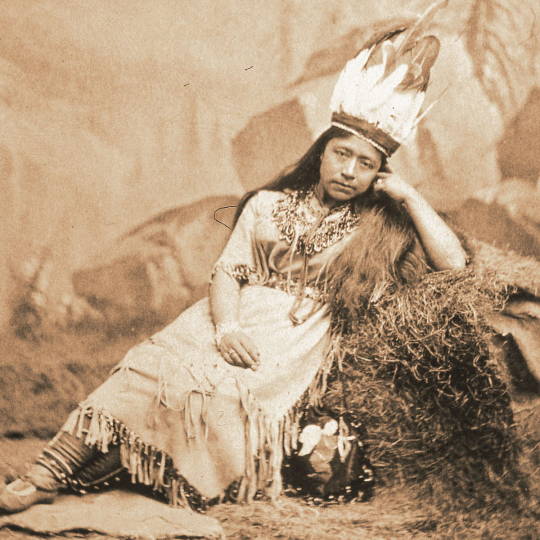
Perhaps the most illuminating account of the region comes from Sarah Winnemucca, daughter of Chief Truckee (after whom the town is named). Sarah travelled as an advocate for Indigenous rights and cataloged her experience and the story of white settler colonization in her book, Life Among the Pauites: Their Wrongs and Claims which you can read for free here.
Thank you for diving into California history with me!
Read Wolfer here.
29 notes
·
View notes
Text
SARAH WINNENUCCA // WRITER
“She was a Northern Paiute writer, activist (lecturer) and educator (school organizer). At 27, Sarah began working in the Bureau of Indian Affairs at Fort McDermitt in 1871 as an interpreter. Subsequently, Winnemucca became an advocate for the rights of Native Americans, traveling across the U.S. to tell Anglo- Americans about the plight of her people. When the Paiute were interned in a concentration camp at Yakima, Washington after the Bannock War, she traveled to Washington, D.C. to lobby Congress and the executive branch for their release. She also served U.S. forces as a messenger, interpreter, and guide, and as a teacher for imprisoned Native Americans. Winnemucca published Life Among the Piutes: Their Wrongs and Claims (1883), a book that is both a memoir and history of her people during their first 40 years of contact with European Americans. It is considered the "first known autobiography written by a Native American woman."”


21 notes
·
View notes
Text
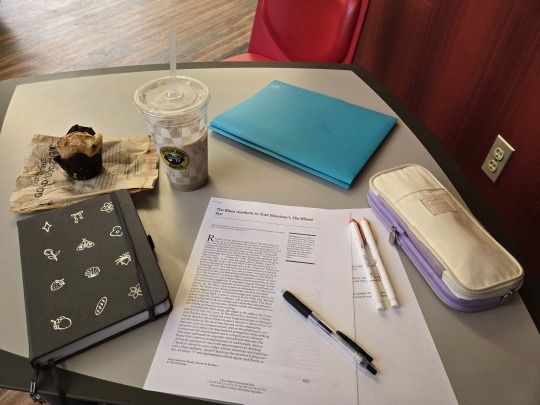

week of september 8, 2024
because of a city-wide power surge i was kept at work until nearly 6:00am tuesday. that coupled with a general trend of me being kept increasingly late and my heavy course load has made for a hectic first few weeks of fall semester. on the bright side, i had an appointment with my psych and i'll be starting a new routine with my meds that i hope will stave off my executive dysfunction when it's time to do homework.
in other news, my boyfriend's birthday is next week, so i'm making plans for us to spend a day at the zoo! i haven't decided what kind of cake i want to bake for the occasion, but knowing him, he'll be happy with anything. quality time with loved ones is just the thing i need to recharge.
current class readings:
The Bluest Eye - Toni Morrison
Devotions upon Emergent Occasions - John Donne
selected readings from Michel Foucault's work
Life Among the Piutes - Sarah Winnemucca
to-do
ASL - units 1.4-1.5
BWN - start essay 1
QT - weekly writing 5
PL - start writing exercise 1
CTM - brainstorm for essay 1 and choose topic
#studyblr#studying#working student#english major#study blog#study#study study study#chaotic academia#college life#college#undergraduate#college struggles#working struggles#study motivation
4 notes
·
View notes
Video
youtube
Sarah Winnemucca Hopkins Life Among the Piutes: Their Wrongs and Claims ...
Image is from Angel, Myron, ed. History of Nevada; with illustrations and biographical sketches of its prominent men and pioneers. Oakland: Thompson and West, 1881.
Image is from https://commons.wikimedia.org/wiki/File:Sarah_Winnemucca_Hopkins.jpg
Image is from https://commons.wikimedia.org/wiki/File:Sarah_Winnemucca_statue.jpg
If you would like to read the full book, you can find many versions in your library or online. This book is in the public domain. You can find it on many sites. Ex. Wikisource, and Google Play Books. Try your local library or digital libraries. Disclaimer: The book is available in the public domain and may contain some historical inaccuracy. I summarize the book to the best of my ability or highlight excerpts of interesting facts. If you would like to add information, advise a current article/book, and/or critically analyze the book, it is welcome. Thank you.
#youtube#SarahWinnemuccaHopkins#LifeAmongThePiutes#piute#paiute#IndigenousPeopleOfAmerica#IndigenousPeopleHistory#history#book#OldBook#books#PublicDomain#HistoryInEverything
2 notes
·
View notes
Text
They Ate People Like Beasts: Sarah Winnemucca Tells of the Red-Haired Indians of Nevada, 1858-1860 - YouTube
0 notes
Text
0 notes
Text
They Ate People Like Beasts: Sarah Winnemucca Tells of the Red-Haired In...
youtube
0 notes
Text
They Ate People Like Beasts: Sarah Winnemucca Tells of the Red-Haired In...
youtube
0 notes
Text
They Ate People Like Beasts: Sarah Winnemucca Tells of the Red-Haired In...
youtube
0 notes
Video
youtube
Sarah Winnemucca -- Life of Paiute: Part 3
1 note
·
View note
Note
Your writing for wolfer is phenomenal! You really capture the setting and period! I was wondering how you prepared for writing this story? It feels like a you did a lot of research.
I’m blushing! 🥰
The setting for Wolfer is part of California I used to visit as a kid. It’s a rugged region of the East Sierras that kinda haunts you, if you’ve ever been.
I started my research about the history of this area when I was working on a Gingerrose historical au. There are plenty of public domain primary source accounts of what Eastern California was like in the late 19th century, such as Life Among the Paiutes by Sarah Winnemucca and My First Summer in the Sierra by John Muir (both depict bluntly the history of racism and displacement of Indigenous tribes, one through a firsthand account, the other through interjections of ugly, racist commentary.)
Today I was working on Wolfer, writing about what Draco has been up to, and I found out all about a Mexican American woman named Miss Lola Travis. According to the Eastern California Museum, she had custody of her two young brothers and three children when her husband died, so she moved up to Owen’s Valley and panned for gold until she had enough money to start a saloon. She kept expanding her businesses with dance halls and brothels until she became one of the most powerful people in Owens Valley.
All that to say, if I keep working and hustling, perhaps I’ll finish this fic before long!
Thanks for reading! 🐺
Click here to check out Wolfer, an old west wizarding AU with dark romance Tomione and star-crossed, brokeback Drarry.
#tomione#drarry#hp edit#hermione x tom#tom riddle#hermione granger#hermione/tom#tom marvolo riddle#draco x harry#hpdm#tom riddle fanfiction#hermione granger fanfiction#harry potter fanfic
6 notes
·
View notes
Text
5 Women Who Deserve More Recognition
Here are 5 women in history who deserve more recognition. I have also included links to content about them so you can learn more :)
1. Maria Theresa, only female ruler ever of the Habsburg dominions
- Wikipedia
- "History Tea Time" Video
2. Josephine Holloway, the first African-American girl scout troop leader.
- Wikipedia
- Girl Scouts
3. Mary Tape, Chinese-American activist and desegregationist.
- Wikipedia
- "A Woman to Know"
4. Margaret Cavendish, philosopher, poet, and author, as well as Duchess of Newcastle-upon-Tyrne.
- Wikipedia
- Stanford Encyclopedia of Philosophy
5. Sarah Winnemucca, Paiute activist and author.
- Wikipedia
- Smithsonian
#herstory#womens history#feminist#herstorshe#sarah winnemucca#maria theresa#mary tape#margaret cavendish#josephine holloway
11 notes
·
View notes